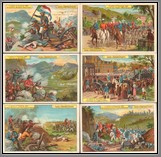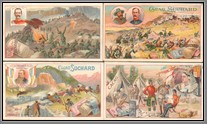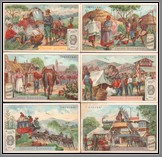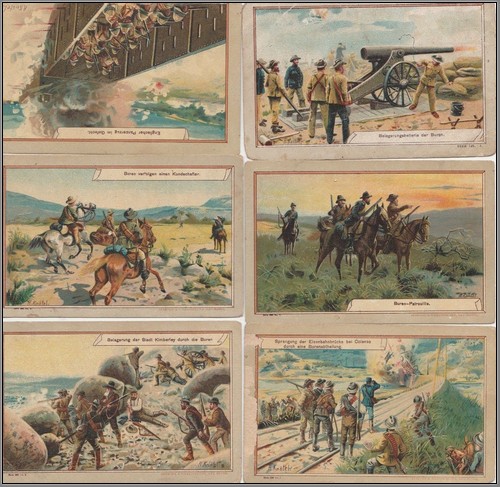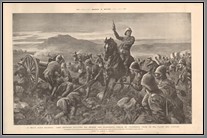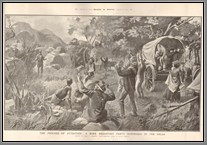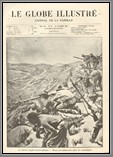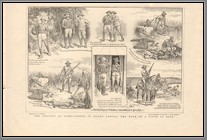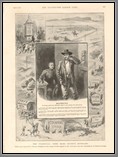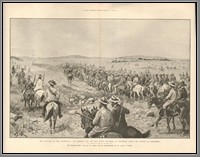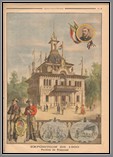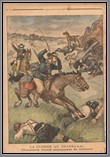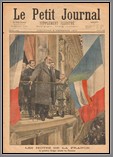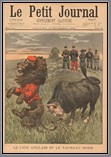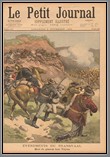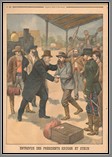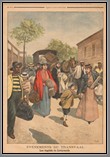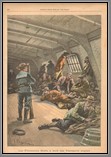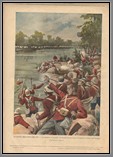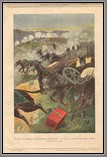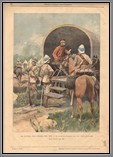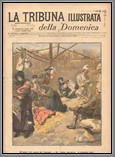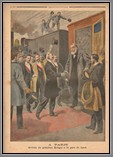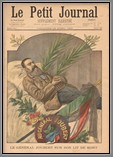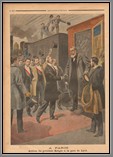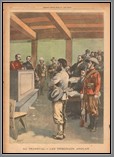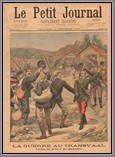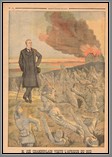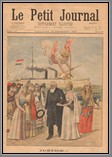Southern Africa
A collection of 15 large double and triple fold-out illustrations of the Second Boer War as well as four other illustrated pages on the same subject. B
Price: $990.00
Note: The Second Boer War was fought between Great Britain and the two Boer (Afrikaner) republics – the Transvaal and the Orange Free State. It was the most expensive war Britain fought between World War I and the Napoleonic War although it was fought on wholly unequal grounds, with British forces reaching almost 500,000 men while the Boers could muster no more than 88,000. 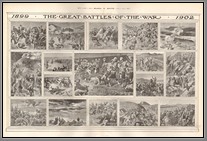 SA 086
SA 086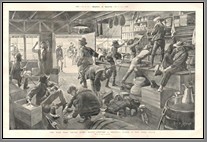 SA 086But the British were fighting in a hostile country over difficult terrain, with long lines of communication, while the Boers, mainly on the defensive, were able to use modern rifle fire to good effect, at a time when attacking forces had no means of overcoming it.
SA 086But the British were fighting in a hostile country over difficult terrain, with long lines of communication, while the Boers, mainly on the defensive, were able to use modern rifle fire to good effect, at a time when attacking forces had no means of overcoming it.
The war began on October 11, 1899, following a Boer ultimatum against the reinforcement of the British garrison on South Africa. The crisis was caused by the refusal of the Transvaal President Kruger to grant political rights ot the Uitlander (non-Dutch and mostly english foreigners) population of the mining areas of the Witwatersrand.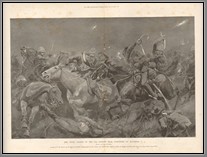 SA 086
SA 086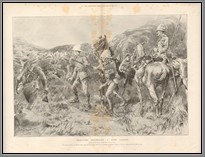 SA 086 An underlying cause of the war was the presence in the Transvaal of the largest gold-mining complex in the world, beyond direct British control, at a time when the world’s monetary systems, preeminently the British, were increasingly dependent upon gold.
SA 086 An underlying cause of the war was the presence in the Transvaal of the largest gold-mining complex in the world, beyond direct British control, at a time when the world’s monetary systems, preeminently the British, were increasingly dependent upon gold.
The course of the war can be divided into three periods. During the first phase, the British in South Africa were unprepared and militarily weak. Boer armies attacked on two fronts, into Natal from the Transvaal and into the northern Cape from the Orange Free State; the northern districts of the Cape Colony rebelled against the British and joined the Boer forces. 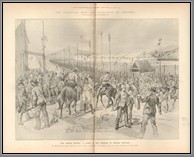 SA 086
SA 086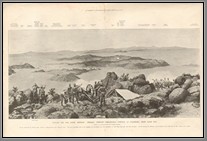 SA 086In the course of the Black Week (December 10-15) the Boers defeated the British in a number of major engagements and besieged the key towns of Ladysmith, Mafeking, and Kimberley; but large numbers of British reinforcements were being landed, and slowly the fortunes of war turned. Before the siege of Ladysmith could be relieved, however, the British suffered another reverse at Spion Kop (January 1900).
SA 086In the course of the Black Week (December 10-15) the Boers defeated the British in a number of major engagements and besieged the key towns of Ladysmith, Mafeking, and Kimberley; but large numbers of British reinforcements were being landed, and slowly the fortunes of war turned. Before the siege of Ladysmith could be relieved, however, the British suffered another reverse at Spion Kop (January 1900).
In the second phase, Lord Kitchener and Earl Roberts relieved the besieged towns, beat the Boer armies in the field, and rapidly advanced up the lines of rail transportation. 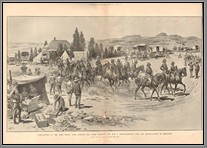 SA 086
SA 086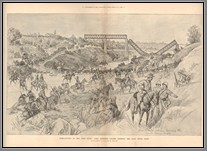 SA 086Bloemfontein was occupied by the British in February 1900, and Johannesburg and Pretoria in May and June. Kruger left the Transvaal for Europe, but the war, which until then had been largely confined to military operations, was by no means at an end, and at the end of 1900 it entered upon its most destructive phase. For 15 months Boer commandos, under the brilliant leadership of generals such as Christiaan Rudolf de Wet and Jacobus Hercules de la Rey, harried the British army bases and communications and large rural areas of the Transvaal and Orange Free State (which the British annexed as the Orange River Colony) remained out of British control.
SA 086Bloemfontein was occupied by the British in February 1900, and Johannesburg and Pretoria in May and June. Kruger left the Transvaal for Europe, but the war, which until then had been largely confined to military operations, was by no means at an end, and at the end of 1900 it entered upon its most destructive phase. For 15 months Boer commandos, under the brilliant leadership of generals such as Christiaan Rudolf de Wet and Jacobus Hercules de la Rey, harried the British army bases and communications and large rural areas of the Transvaal and Orange Free State (which the British annexed as the Orange River Colony) remained out of British control.
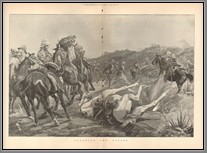 SA 086
SA 086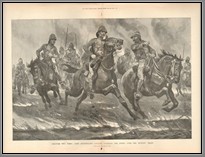 SA 086Kitchener responded with barbed wire and blockhouses along the railways, but when these failed he retaliated with a scorched-earth policy. The farms of Boers and Africans alike were destroyed and the Boer inhabitants of the countryside were rounded up and held in segregated concentration camps (Note: this is the origin of the term ‘concentration camp’). The plight of the Boer women and children in these camps became an international outrage – more than 20,000 died in the carelessly run, unhygienic camps. The commandos continued their attacks, many of them deep in the Cape Colony, General Jan Smuts leading his forces to within 50 miles of Capetown. But Kitchener’s drastic and brutal methods slowly paid off. The Boers had unsuccessfully sued for peace in March, 1901; finally, they accepted the loss of their independency by the Peace of Vereennging.
SA 086Kitchener responded with barbed wire and blockhouses along the railways, but when these failed he retaliated with a scorched-earth policy. The farms of Boers and Africans alike were destroyed and the Boer inhabitants of the countryside were rounded up and held in segregated concentration camps (Note: this is the origin of the term ‘concentration camp’). The plight of the Boer women and children in these camps became an international outrage – more than 20,000 died in the carelessly run, unhygienic camps. The commandos continued their attacks, many of them deep in the Cape Colony, General Jan Smuts leading his forces to within 50 miles of Capetown. But Kitchener’s drastic and brutal methods slowly paid off. The Boers had unsuccessfully sued for peace in March, 1901; finally, they accepted the loss of their independency by the Peace of Vereennging.
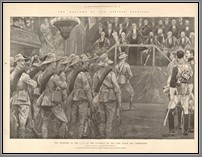 SA 085 SA 085 |  SA 085 SA 085 |  SA 085 SA 085 |
The participation of the local native population in the Second Boer is the subject of these 13 illustrations from French and English periodicals. The natives are shown as laborers, guides, prisoners, spies and actually fighting under arms with the Boers. B
Price: $720.00
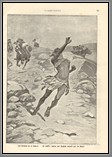 SA 085 SA 085 | 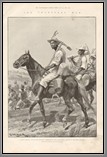 SA 085 SA 085 | 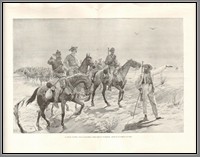 SA 085 SA 085 | 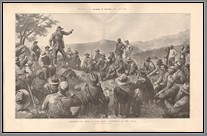 SA 085 SA 085 |
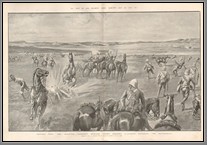 SA 085 SA 085 | 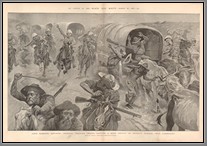 SA 085 SA 085 | 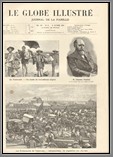 SA 085 SA 085 | 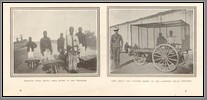 SA 085 SA 085 |
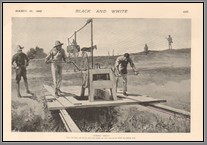 SA 085 SA 085 | 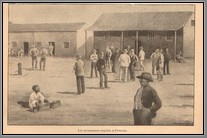 SA 085 SA 085 | 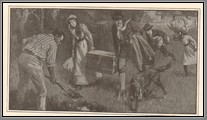 SA 085 SA 085 | 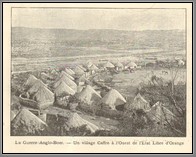 SA 085 SA 085 |
Eight illustrations from the first Boer War (1880-1881) and the Jameson Raid (1895) and the laters aftermath. Includes political satire from Punch Magazine in 1897. B
Price: $230.00
Note: The First Anglo-Boer War was a military conflict in South Africa between the Boer Republic of South Africa, also known as Transvaal, and the British Empire. 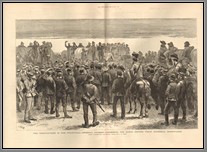 SA 083The war ended in firm Boer victory, and embarrassing losses for the British. It was the first major loss of Great Britain since the American War of Independence and led to the second independence of the South African Republic.
SA 083The war ended in firm Boer victory, and embarrassing losses for the British. It was the first major loss of Great Britain since the American War of Independence and led to the second independence of the South African Republic.
The Jameson Raid was an ineffective attempt to overthrow President Paul Kruger of the Transvaal Republic in December 1895. There are several reasons why the Jameson Raid took place.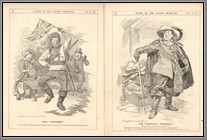 SA 083
SA 083
Tens of thousands of uitlanders had settled in the Transvaal following the discovery of gold on the Witwatersrand in 1886. The influx threatened the political independence of the recently formed republic (negotiated at the 1884 London Convention, three years after the 1st Anglo-Boer War). Transvaal relied on revenue generated by the gold mines, but the government refused to grant the uitlanders the franchise, and kept upping the period required to qualify for citizenship.
The Transvaal government was considered to be excessively conservative over economic and industrial policy, and the various non-Afrikaner mining magnates in the region desired a greater political voice.
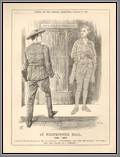 SA 083There was a significant level of distrust between the Cape Colony government and that of the Transvaal republic over Kruger's attempt to claim control of Bechuanaland in contravention of the 1884 London Convention. The region was subsequently declared a British protectorate.
SA 083There was a significant level of distrust between the Cape Colony government and that of the Transvaal republic over Kruger's attempt to claim control of Bechuanaland in contravention of the 1884 London Convention. The region was subsequently declared a British protectorate.
Leander Starr Jameson, who led the raid, had first arrived in Southern Africa in 1878, lured by the discovery of diamonds near Kimberley. Jameson was a qualified medical doctor, known to his friends (including Cecil Rhodes, one of the founders of the De Beers Mining Company who became premier of Cape Colony in 1890) as Dr Jim.
In 1889 Cecil Rhodes formed the British South Africa (BSA) Company, which was given a Royal Charter, and with Jameson acting as emissary, sent a 'Pioneer Column' across the Limpopo River into Mashonaland (what is now the northern part of Zimbabwe) and then into Matabeleland 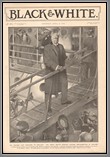 SA 083(now south-west Zimbabwe and parts of Botswana). Jameson was given the post of administrator for both regions. In 1895 Jameson was commissioned by Rhodes (now prime minister of Cape Colony) to lead a small mounted force (around 600 men) into the Transvaal to support an expected uitlander uprising in Johannesburg. They departed from Pitsani, on the Bechuanaland (now Botswana) border on 29 December. 400 Men came from the Matabeleland Mounted Police, the rest were volunteers. They had six Maxim guns and three light artillery pieces.
SA 083(now south-west Zimbabwe and parts of Botswana). Jameson was given the post of administrator for both regions. In 1895 Jameson was commissioned by Rhodes (now prime minister of Cape Colony) to lead a small mounted force (around 600 men) into the Transvaal to support an expected uitlander uprising in Johannesburg. They departed from Pitsani, on the Bechuanaland (now Botswana) border on 29 December. 400 Men came from the Matabeleland Mounted Police, the rest were volunteers. They had six Maxim guns and three light artillery pieces.
The uitlander uprising failed to materialize. Jameson's force made first contact with a small contingent of Transvaal soldiers on 1 January, who had blocked the road to Johannesburg. Withdrawing during the night, Jameson's men tried to outflank the Boers,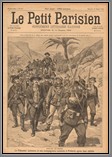 SA 083 but were finally forced to surrender on 2 January 1896 at Doornkop, approximately 20km west of Johannesburg. Jameson and various uitlander leaders were handed over to British authorities in the Cape and sent back to the UK for trial in London. Initially they were convicted of treason and sentenced to death for their part in the plan, but the sentences were commuted to heavy fines and token prison stays - Jameson served only four months of a 15 month sentence. The British South Africa Company was required to pay nearly £1 million in compensation to the Transvaal government.
SA 083 but were finally forced to surrender on 2 January 1896 at Doornkop, approximately 20km west of Johannesburg. Jameson and various uitlander leaders were handed over to British authorities in the Cape and sent back to the UK for trial in London. Initially they were convicted of treason and sentenced to death for their part in the plan, but the sentences were commuted to heavy fines and token prison stays - Jameson served only four months of a 15 month sentence. The British South Africa Company was required to pay nearly £1 million in compensation to the Transvaal government.
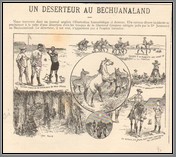 SA 083President Kruger gained much international sympathy (the Transvaal's David verses the Goliath of the British empire), and bolstered his political standing at home (he won the 1896 presidential election against a strong rival Piet Joubert) because of the raid. Cecil Rhodes was forced to retire as prime minister of the Cape Colony, and never truly regained his prominence, although he negotiated a peace with various Matabele indunas in his fiefdom of Rhodesia. Leander Starr Jameson returned to South Africa in 1900, and after the death of Cecil Rhodes in 1902 took over leadership of the Progressive Party. He was elected prime minister of the Cape Colony in 1904 and lead the Unionist Party after the Union of South Africa in 1910. Jameson retired from politics in 1914 and died in 1917.
SA 083President Kruger gained much international sympathy (the Transvaal's David verses the Goliath of the British empire), and bolstered his political standing at home (he won the 1896 presidential election against a strong rival Piet Joubert) because of the raid. Cecil Rhodes was forced to retire as prime minister of the Cape Colony, and never truly regained his prominence, although he negotiated a peace with various Matabele indunas in his fiefdom of Rhodesia. Leander Starr Jameson returned to South Africa in 1900, and after the death of Cecil Rhodes in 1902 took over leadership of the Progressive Party. He was elected prime minister of the Cape Colony in 1904 and lead the Unionist Party after the Union of South Africa in 1910. Jameson retired from politics in 1914 and died in 1917.

